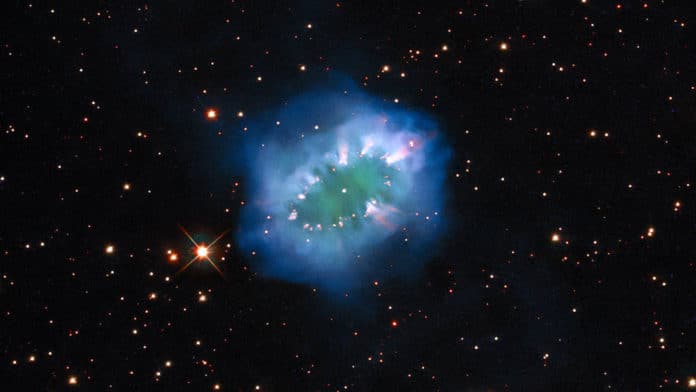Welcome to DU!
The truly grassroots left-of-center political community where regular people, not algorithms, drive the discussions and set the standards.
Join the community:
Create a free account
Support DU (and get rid of ads!):
Become a Star Member
Latest Breaking News
General Discussion
The DU Lounge
All Forums
Issue Forums
Culture Forums
Alliance Forums
Region Forums
Support Forums
Help & Search
Science
Related: About this forumHubble captured a view of the Necklace Nebula
A diamond necklace of cosmic proportions.
BY
AMIT MALEWAR
MAY 1, 2021

Credit: ESA/Hubble & NASA, K. Noll
Using advanced processing techniques, Hubble created an improved and fresh view of an intriguing object, the Necklace Nebula. The nebula is located 15,000 light-years away from Earth in the constellation of Sagitta.
Also known as PN G054.203.4, the nebula is produced by a pair of tightly orbiting Sun-like stars.
Roughly 10,000 years ago, one of the aging stars expanded and expanded its smaller companion, which some astronomers call a “common envelope.” The smaller star continued to orbit inside its larger partner, increasing the bloated giant rotation rate until large parts were ejected into space. This leftover ring of debris formed the necklace nebula.
The stars that created the nebula remain so close together – separated by only several million miles. In this image, both stars appear as a single bright dot in the center of this image. Despite their close encounter, the stars are still furiously whirling around each other, completing an orbit in just over a day.
https://www.techexplorist.com/hubble-captured-view-necklace-nebula/38849/
InfoView thread info, including edit history
TrashPut this thread in your Trash Can (My DU » Trash Can)
BookmarkAdd this thread to your Bookmarks (My DU » Bookmarks)
4 replies, 2233 views
ShareGet links to this post and/or share on social media
AlertAlert this post for a rule violation
PowersThere are no powers you can use on this post
EditCannot edit other people's posts
ReplyReply to this post
EditCannot edit other people's posts
Rec (33)
ReplyReply to this post
4 replies
 = new reply since forum marked as read
Highlight:
NoneDon't highlight anything
5 newestHighlight 5 most recent replies
= new reply since forum marked as read
Highlight:
NoneDon't highlight anything
5 newestHighlight 5 most recent replies
Hubble captured a view of the Necklace Nebula (Original Post)
Judi Lynn
May 2021
OP
Happyhippychick
(8,379 posts)1. Absolutely breathtaking
soothsayer
(38,601 posts)2. Spectacular and aptly named
notKeith
(138 posts)3. some maybe faulty math
If these are sun-like stars, then we're talking about 2 stars around 860,000 miles in diameter.
And if 'several million' - taking a stab here - is 3.5M, then for these stars to circle each other in around 24 hours means they're travelling at close to 460,000 mph. Wouldn't want to be close to 'em.
niyad
(113,286 posts)4. So very beautiful.